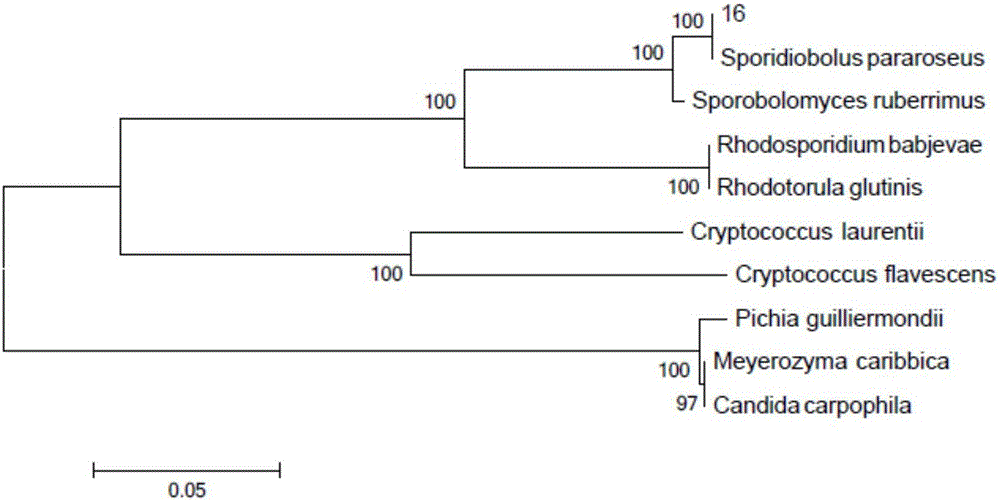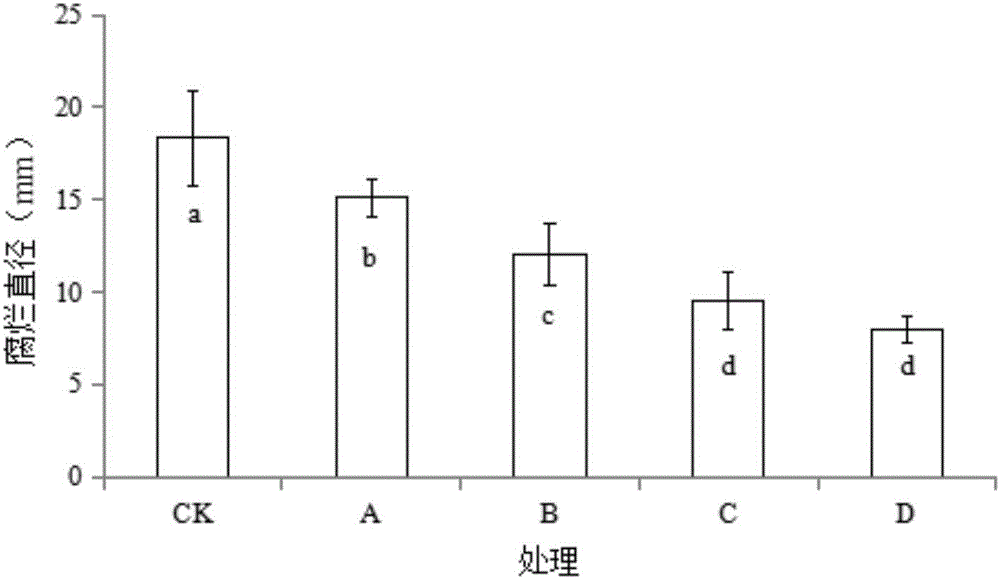Saccharomycete for controlling postharvest penicilliosis of malus domestica and application of saccharomycete
A technology for penicillium and yeast, which is applied in the fields of application, fungi, and fruit and vegetable preservation, etc., to achieve strong antagonism, avoid harm to people and the environment, and be easy to operate
- Summary
- Abstract
- Description
- Claims
- Application Information
AI Technical Summary
Problems solved by technology
Method used
Image
Examples
Embodiment 1
[0020] Embodiment 1: the microbiological characteristics of Septoria pseudopina:
[0021] 1. Morphological features
[0022] (1) Cultivate on NYDA solid medium plate (yeast extract 5g, beef extract 8g, glucose 10g, distilled water 1000mL, agar 20g, 121°C damp heat sterilization for 20min) at 28°C for 48h, the colonies are round and pink The colonies are relatively moist and easy to stir up. The cells are oblong in shape and scattered individually.
[0023] (2) After culturing in NYDB liquid medium for 24 hours, no mold was formed, and the bacterial solution was turbid with precipitation. Microscopically, the yeast cells were oval and budded.
[0024] 2. Molecular biological identification
[0025] Sequence analysis of the 5.8S rDNA-ITS region of the screened strain S. pararoseus 16 was searched on GenBank, and it was identified as Sporidiobolus pararoseus. According to the retrieved homologous strains, the Mege5.1 program of DNAStar software was used to construct the biolo...
Embodiment 2
[0027] Embodiment 2: the safety study of Septoria pseudopinnata 16
[0028] The animals used are ICR mice, provided by the Experimental Animal Center of Jiangsu University, clean grade. Each experimental group consisted of 20 mice, half male and half male. Adopt the way of gavage, according to 0.1mL / l0g body weight (10000mg / kg dosage group presses 0.2mL / 10g body weight) to give test substance, the concentration of yeast is made into 1×10 9 cells / mL of bacterial suspension, and the control group (CK) was filled with the same amount of sterile water. The experiment continued for 15 days, and the mice infused with yeast did not die within 15 days, and the mice did not appear to be poisoned during the whole experiment. According to the national standard of acute toxicity test, it can be judged that the experimental yeast is safe and non-toxic. The experimental results are shown in Table 1.
[0029] Table 1 Toxicity test on mice of S. pseudopinnata 16
[0030]
Embodiment 3
[0031] Embodiment 3: the control effect of Sclerosporium pseudopina to postharvest blue mold of apples
[0032] The activated yeast was inoculated into a conical flask filled with 50 mL of NYDB (5 g of yeast extract, 8 g of beef extract, 10 g of glucose, and 1000 mL of distilled water), and cultured on a shaker at 28°C and 180 rpm for 20 h. Take the bacterial solution and centrifuge it at 8000rpm for 10min, discard the supernatant, wash it repeatedly with sterile water for 3 times, and count it on the hemocytometer to make a concentration of 1×10 6 / mL to 1×10 9 Bacterial suspension per mL, three wounds (5mm×3mm) with uniform distribution, uniform size and depth were made on the equatorial part of the apple fruit surface with a sterilized puncher. Use a pipette to inject 30 μL (1) S. pararoseus yeast suspension (concentration 1×10 6 -10 9 Individuals / mL four gradients); (2) sterile distilled water (control). After standing for 2 hours, inject 30 μL of P.expansum spore susp...
PUM
 Login to View More
Login to View More Abstract
Description
Claims
Application Information
 Login to View More
Login to View More - R&D
- Intellectual Property
- Life Sciences
- Materials
- Tech Scout
- Unparalleled Data Quality
- Higher Quality Content
- 60% Fewer Hallucinations
Browse by: Latest US Patents, China's latest patents, Technical Efficacy Thesaurus, Application Domain, Technology Topic, Popular Technical Reports.
© 2025 PatSnap. All rights reserved.Legal|Privacy policy|Modern Slavery Act Transparency Statement|Sitemap|About US| Contact US: help@patsnap.com



